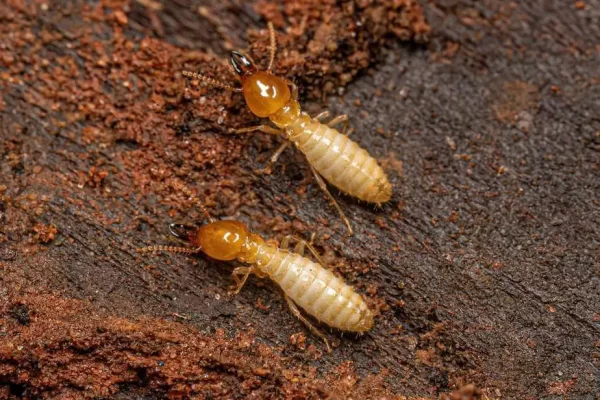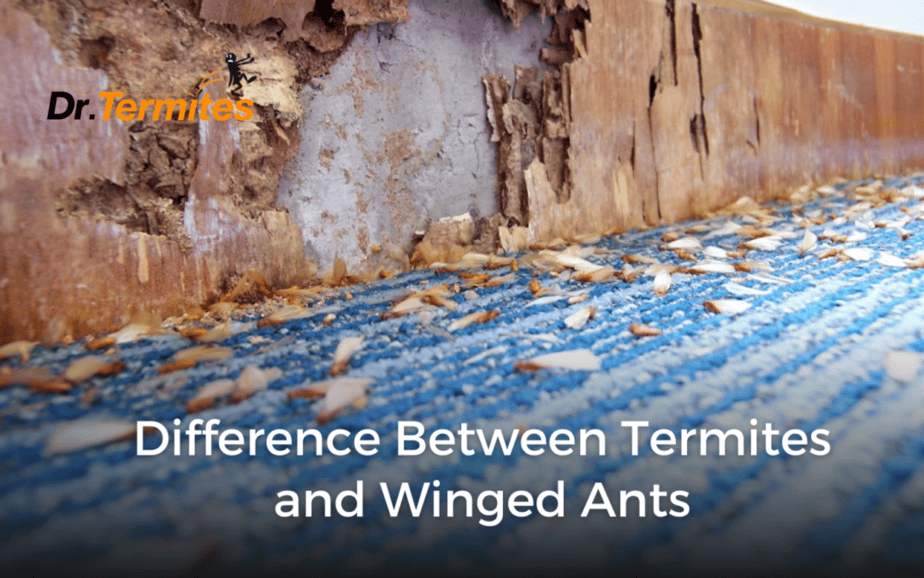The appearance of winged insects inside your home can often lead to confusion. Are they termites or winged ants?
While at a glance they might seem similar, numerous differences exist between these two species. Recognizing these differences is crucial for homeowners, as the presence of one over the other can significantly impact the approach to pest management.
This blog post will provide a detailed comparison to help you identify whether you’re dealing with termites or winged ants, aiding in effective termite control.

Physical Differences
Body Shape
One of the most noticeable differences lies in their body shapes. Termites have a relatively uniform body width from head to abdomen, giving them a more cylindrical appearance. On the other hand, winged ants exhibit a pronounced constriction at their waist, creating a distinct division between their thorax and abdomen, which gives them a pinched waist look.
Antennae
Another key feature to observe is the antennae. Termites possess straight antennae that appear bead-like in structure. In contrast, winged ants have elbowed antennae, which bend at an angle and are often longer compared to those of termites.
Wing Size and Shape
Both termites and winged ants have two pairs of wings, but the similarities end there. For termites, all four wings are of equal size and shape, and they are much longer than their body. These wings are also translucent with a delicate, almost filmy appearance. Winged ants, however, have a noticeable difference in the size of their wings. Their front pair of wings are larger and more robust than the rear pair, and the wings are not as proportionally long as those of termites when compared to their body length.
Color
While color can vary significantly within species, it can still serve as a helpful indicator. Generally, termites tend to be lighter in color, ranging from white to light brown. Winged ants, especially common varieties such as carpenter ants, are usually darker, with colors spanning from black to dark brown.
Behavioral Differences
Beyond the physical distinctions, termites and winged ants exhibit notable differences in their behavior, which can aid in identification and understanding of their impact on your home.
Nesting Habits
Termites are known for building their colonies underground or within wooden structures, creating elaborate tunnel systems. This behavior is a significant reason why termite infestations can go unnoticed until substantial damage has been done. Winged ants, however, typically establish their nests in moist areas or rotting wood outside and occasionally venture into homes in search of food.
Swarm Behavior
Swarming is a common reproductive activity for both termites and winged ants, but the timing and nature of these swarms can differ. Termites tend to swarm in the spring, especially after a rain shower when humidity is high. Ants might also swarm during warmer months, but their swarming doesn’t have the same predictability in terms of timing and environmental conditions.
Diet Preferences
The diet is a clear indicator of their differing behaviors. Termites consume cellulose, primarily found in wood, making them notorious for damaging wooden structures. Winged ants, on the other hand, have a more varied diet that can include sweets, proteins, and even other insects, reducing their direct threat to the structural integrity of buildings.
Significance of Correct Identification
Understanding whether you’re dealing with termites or winged ants is critical because of the potential damage they can cause. Termites are capable of causing significant structural damage to homes by eating wood, while winged ants are less likely to cause such extensive harm.
Correctly identifying these pests is the first step in implementing effective termite control measures. Knowing you’re dealing with termites can prompt swift action, potentially saving homeowners considerable repair costs.
Termites vs. Winged Ants: The Key to Protecting Your Home from Unseen Invaders
Distinguishing between termites and winged ants is essential for homeowners looking to protect their properties from unnecessary damage. By paying attention to physical and behavioral differences, such as body shape, antenna structure, wing size, and swarming habits, you can accurately identify these pests.
Proper identification is the cornerstone of effective pest management and is particularly crucial for implementing successful termite control strategies. If unsure, consulting with a pest control professional can provide peace of mind and ensure that your home remains safe from these potentially damaging insects.
At Dr. Termites, we understand the urgency and importance of accurate pest identification and prompt, effective treatment. Our team is equipped with the knowledge and tools needed to respond to your termite control needs efficiently. If you’re facing uncertainty about the type of pest in your home, or if you’ve identified termites and need immediate action, Dr. Termites is ready to assist.
Protect your home from termites with Dr. Termites. Get a comprehensive inspection and customized control solutions for lasting protection. Your peace of mind is our commitment.































